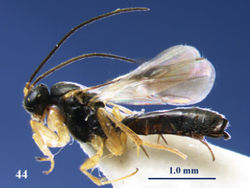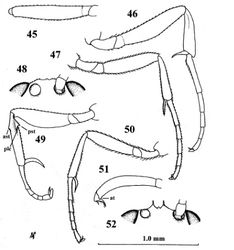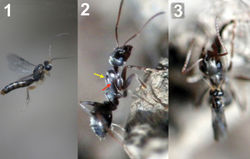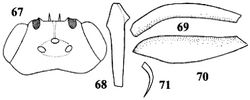| 1 | | | Females: third and following antennal segments with short and adpressed setae; fore tibia widened subbasally (Figs 46, 49); metasoma apically with a strongly downcurved ovipositor and a short and elliptical ovipositor sheath (Fig. 53) | | | 2 |
| |
|
| – | | | Males: third and following antennal segments with medium-sized and erect setae; fore tibia narrow subbasally (Figs 47, 50); ovipositor and ovipositor sheath absent | | | 7Note. Males are unknown of the C. Asian Neoneurus curvicalcar Belokobylskij, 1986, and the European Neoneurus vesculussp. n. and Neoneurus recticalcar sp. n. |
| |
|
| 2 | | | Fore femur straight in dorsal view (Fig. 45) and comparatively narrow in lateral view (Fig. 46); face without facial tubercles and bristles (Fig. 48); fore tibia without protuberances (Fig. 46); fore basitarsus 0.7–0.9 times as long as fore tibia (Fig. 46); [fore tibial spur 0.3–0.5 times hind basitarsus and its apical half narrow (Fig. 46); vertex finely transversely striate or rugulose; tegulae pale yellowish; anterior subalar prominence pale dark brown; pedicellus brown, darker than yellowish scapus; only European species with entirely black or dark brown metasoma]; W & E Palaearctic | | | Neoneurus auctus (Thomson, 1895) |
| |
|
| – | | | Fore femur curved in dorsal view (Figs 51, 56, 59, 69) and comparatively wide in lateral view (Figs 50, 58, 70); face with pair of facial tubercles and a central bristle (Figs 52, 57, 60, 62, 67); fore tibia with protuberances (Figs 49, 55, 58, 63, 68); fore basitarsus about 0.5 times as long as fore tibia and apical half gradually narrowed (Figs 49, 55, 58) | | | 3 |
| |
|
| 3 | | | Anterior subbasal tooth of fore tibia minute (Figs 49, 55); posterior longitudinal carina of fore tibia short (Figs 49, 55) | | | 4 |
| |
|
| – | | | Anterior subbasal tooth of fore tibia wide triangular (Figs 58, 68); posterior longitudinal carina of fore tibia long, surpassing middle of tibia (Fig. 58) | | | 5 |
| |
|
| 4 | | | Fore tibial spur nearly straight and 0.7–0.8 times as long as fore basitarsus (Fig. 55); facial tubercles minute, with slender bristle and distance between bristles 1.2–1.3 times width of scapus (Fig. 57); apical tooth of fore femur medium-sized (Fig. 56); fore tibia 4.5–5.0 times as long as wide (Fig. 57); mesopleuron sometimes partly pale yellowish medially; W Palaearctic | | | Neoneurus recticalcar van Achterberg, sp. n. |
| |
|
| – | | | Fore tibial spur strongly curved and 0.8–0.9 times as long as fore basitarsus (Fig. 49); facial tubercles medium-sized, with robust bristle and distance between bristles about equal to width of scapus (Fig. 52); apical tooth of fore femur minute (Fig. 51); fore tibia about 6 times as long as wide (Fig. 49); mesopleuron dark brown medially; W & E Palaearctic | | | Neoneurus clypeatus (Foerster, 1862) |
| |
|
| 5 | | | Posterior longitudinal carina of fore tibia with a submedial thorn-like protuberance; facial tubercles thick and nearly as long as pedicellus; [fore tibial spur distinctly curved in both sexes]; E Palaearctic (Mongolia) | | | Neoneurus armatus Tobias, 1977 |
| |
|
| – | | | Posterior longitudinal carina of fore tibia without a submedial thorn-like protuberance (Figs 58, 68); facial tubercles shorter than pedicellus (Figs 60, 67) | | | 6 |
| |
|
| 6 | | | Pair of facial bristles minute, 0.2 times as long as pedicellus and distance between bristles about 1.2 times width of scapus (Fig. 60); posterior subbasal tooth of fore tibia small, narrow (Fig. 58); SW Palaearctic | | | Neoneurus vesculus van Achterberg & Gómez, sp. n. |
| |
|
| – | | | Pair of facial bristles medium-sized, about as long as pedicellus and distance between bristles about equal to width of scapus (Fig. 67); posterior subbasal tooth of fore tibia medium-sized, wide triangular or falcate (Fig. 68); E Palaearctic (Kazakhstan) | | | Neoneurus curvicalcar Belokobylskij, 1986 |
| |
|
| 7 | | | Hind femur partly dark brown or black; fore tibial spur strongly curved; [vertex finely granulate; clypeus black]; Mongolia | | | Neoneurus armatus Tobias, 1977 |
| |
|
| – | | | Hind femur yellowish-brown or brown, sometimes infuscate basally; fore tibial spur moderately curved or nearly straight (Figs 47, 50) | | | 8 |
| |
|
| 8 | | | Length of fore tarsus 1.8–2.0 times fore tibia and tibia widened apically (Fig. 47); fore tibial spur straight or nearly so and with medium-sized setae (Fig. 47); clypeus with satin sheen and transversely striate; epistomal suture obsolescent laterally; vertex dorsally transversely striate or rugulose; W & E Palaearctic | | | Neoneurus auctus (Thomson, 1895) |
| |
|
| – | | | Length of fore tarsus 1.2–1.5 times fore tibia and tibia slender apically (Fig. 50); fore tibial spur moderately curved and with short setae (Fig. 50); clypeus shiny and smooth or nearly so; epistomal suture distinct laterally; vertex dorsally finely granulate or coriaceous; W & E Palaearctic | | | Neoneurus clypeatus (Foerster, 1862) |
| |







